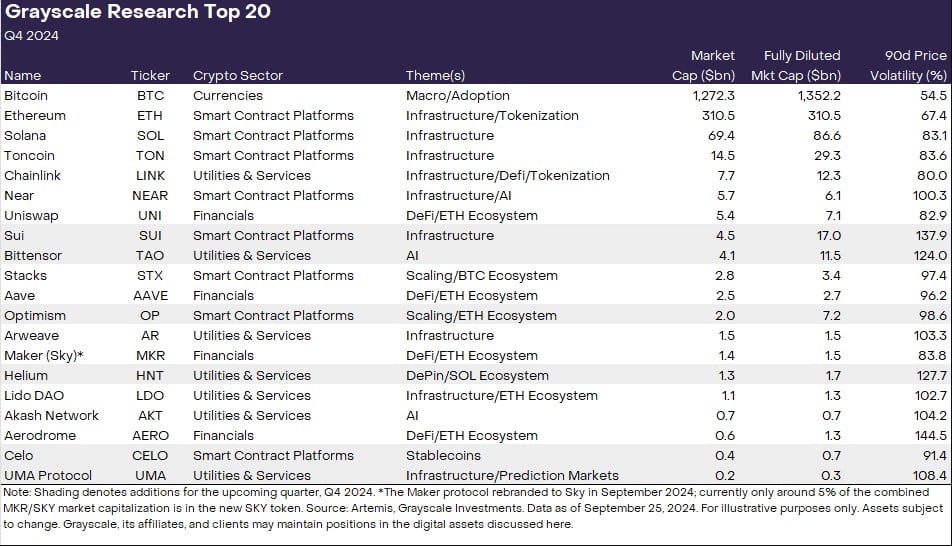Key Insights
- Grayscale introduces new cryptocurrencies including Sui and Bittensor to its top 20 list for the fourth quarter of 2024.
- The revised list emphasizes areas like decentralized AI and the tokenization of traditional assets.
Share this article
With the year’s last quarter just around the corner, Grayscale Research has unveiled its updated list of the top 20 cryptocurrencies poised for growth in the upcoming quarter. This revised list features six new altcoins, namely Sui (SUI), Bittensor (TAO), Optimism (OP), Celo (CELO), Helium (HNT), and UMA Protocol (UMA).
Grayscale Research indicates that these newcomers reflect the market trends the team is currently monitoring.
“The Top 20 comprises a diverse collection of assets across various Crypto Sectors that, in our estimation, have significant potential in the upcoming quarter. Our strategy considers several factors, including network growth/adoption, imminent catalysts, sustainability of fundamentals, token valuation, token supply inflation, and potential risks,” stated the team.
“Grayscale believes these new entries, in conjunction with the existing assets on the Top 20, present attractive investment options with prospects for growth and strong risk-adjusted returns,” they added.
The focal points identified are decentralized AI, efficient infrastructure, and projects showcasing “distinct adoption patterns.” Grayscale Research also highlights the rise of decentralized AI platforms, traditional asset tokenization, and the enduring interest in memecoins as significant emerging trends.

As per the team, Sui has been recognized for its 80% increase in transaction speed following a network upgrade, while Bittensor is advancing the blend of cryptocurrency and AI. Notably, Grayscale currently presents trust products for both Sui and Bittensor, specifically the Grayscale Sui Trust and the Grayscale Bittensor Trust, which were launched last month.
Optimism, recognized as an Ethereum layer 2 solution, and Helium, known for its decentralized physical infrastructure networks, are also featured, while Celo’s transition to an Ethereum layer 2 network and its growing adoption in payment solutions are vital factors in its inclusion.
The rise in Celo’s stablecoin usage has been acknowledged not just by Grayscale Research, but also by Vitalik Buterin. The co-founder of Ethereum recently lauded Celo’s achievement in daily active stablecoin addresses, spurred by increased app adoption and demand within Africa.
UMA Protocol, which supports the Polymarket prediction platform, is the last addition. UMA’s position on the list underscores the critical role of oracles in blockchain predictive markets.
Bitcoin, Ethereum, and Solana Remain Prominent
Established crypto assets like Bitcoin, Ethereum, and Solana continue to hold the top positions in Grayscale’s portfolio. According to the research team, Bitcoin and the broader crypto sector have surpassed other segments this year, likely due to the introduction of US spot Bitcoin ETFs and favorable macroeconomic conditions.
As the analysis suggests, Ethereum has underperformed compared to Bitcoin but has outshone most other crypto assets. Despite facing competition from strong blockchains like Solana, Ethereum retains its dominance in terms of applications, developer activity, fee revenue, and total value locked.
Grayscale Research anticipates growth across the entire smart contract platform sector, which is likely to benefit Ethereum due to its network effects. Beyond Ethereum’s high reliability, security, and decentralization, the team believes that its regulatory standing offers a competitive advantage over rival networks.
In addition to welcoming new cryptocurrencies, the research team has removed six from the list. These tokens include Render, Mantle, THORChain, Pendle, Illuvium, and Raydium. The team asserts that while these assets still maintain value within the wider crypto ecosystem, the newly revised list offers more attractive risk-adjusted returns for the upcoming quarter.
Grayscale Research also advises caution regarding the inherent risks associated with cryptocurrency investments, highlighting the high volatility and unique challenges such as smart contract vulnerabilities and regulatory uncertainties.








